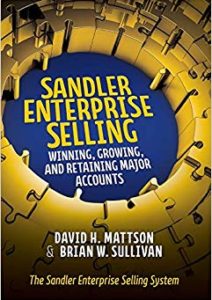In selling to and serving major accounts, no matter how effective you are, you must face a harsh truth. Losing happens. Regardless of your focus, time and effort, you’re certain to come up short on occasion.
In the grief following a major loss, someone in the selling organization will always say, “We should learn from this and make sure it never happens again”. It makes so much sense that there’s even a memorable phrase often uttered – “You win or you learn”. As practical as that sounds, it’s fascinating that many talented selling organizations fail miserably in their attempts at post-mortems. Selling teams with laser-focused pursuit processes crumble in trying to learn from defeats. Loss review meetings are often filled with confusion, finger-pointing, group hugs and other awkward interactions. After about twenty minutes, someone mercifully shuts things down by lamenting, “Let’s go win the next one!”. So, how is it that so many sophisticated selling organizations with truly talented people fail in their attempts to review losses? It’s simple – human nature.
Think about all the popular publications that celebrate the best local physicians – the top dermatologists, cardiologists, pediatricians, etc. What about the top coroners? Do they ever get recognized? Never, regardless of their clear value. Why not? Because they engage after the loss. Autopsy time. The knowledge they provide is immensely constructive. In selling, though, we’d rather not think about it. We look away. “Let’s go win the next one!”.
Matthew Syed wrote a fascinating book called Black Box Thinking, highlighting that success happens only when we constructively face our mistakes. He thoroughly investigates healthcare and its dysfunctional perspective on failure by sharing the incredibly high numbers of people who die due to doctors’ mistakes. He compares that travesty to aviation’s open attitude about failure and how its excellent safety record is driven by the fact that mistakes aren’t concealed but openly analyzed and learned from. And black boxes provide the framework.
Back to major account losses. Moving on, as mentioned, is human nature. But there’s another practical reason why otherwise capable selling organizations are ineffective at reviewing losses. They have no frameworks to follow. And truthfully, frameworks should be crafted long before a deal is won or lost. In fact, before the decision is made to pursue an opportunity. It begins with an established Go/No-Go process to help identify the opportunities with the highest probability of success. Your ability to target these most winnable deals is huge. But how do you do it?
You start with a candid assessment of your organization’s strengths and weaknesses and then align it with what constitutes a profile opportunity in your world. This dynamic combination should be part of your organization’s pursuit of DNA. Simply stated, it’s the foundation of your Go/No-Go decisions. In Sandler Enterprise Selling, we follow the Pursuit Navigator framework, which separates an opportunity’s issues into three categories – Client Issues, Selling Team Issues, and Finance/Contract Issues. Utilizing team selling, individuals from across the organization evaluate the issues to determine the level of stability or risk for each. For example, do you have relationships with multiple contacts at different levels of the account? Do you understand your competition, their account relationships, and solutions? What about the proposed contract? Are there guarantees, warranties or penalties and do you understand their implications? Think about these questions. Why would you not evaluate them? How could you possibly consider proceeding without clearly understanding their consequences?
If you decide that you’re stable regarding an issue, you note it and move to the next. But where risk is identified, you must determine actions to take. Developing concrete mitigation plans quickly is critical. Nothing good comes from delaying. In enterprise pursuits, the clock is ticking.
The results of these efforts provide the intelligence needed for your Go/No-Go decisions. If you proceed having mitigated risks as effectively as possible, your due diligence has increased your probability of winning. But nothing is guaranteed. Remember, losing happens. But the Go/No-Go process delivers value even after a loss as it provides that post-mortem framework – the black box. In the sting of losing, you revisit the issues and the risks you mitigated. You missed something. Maybe you underestimated an impact, ignored a dependency or gave yourself more benefit of the doubt than you deserved. In any case, the intelligence that dictated your decision to proceed was compelling. At least at the time. Reviewing it now, in the clarity of losing, helps you avoid making the same mistakes again.
After major defeats, the temptation is to turn the page and move on. It’s human nature. But boldly facing your mistakes is the prescription for improvement. So, build your own black box as your Go/No-Go framework and guide. It’ll drive continuous learning, growth and future wins.













Comments (6)
wow,its a productive one
Impressive nice article on learning through mistakes and build my own black box as my Go/No-Go framework and guide. It’ll drive continuous learning, growth and future wins.
Yes, I agree. Face your mistakes. Learn from them, keep learning and move on. Awesomely written.
The major thing is that learning from mistakes and never repeating the mistakes again.
Nice write up
Learning through mistakes. Great way to move grow.